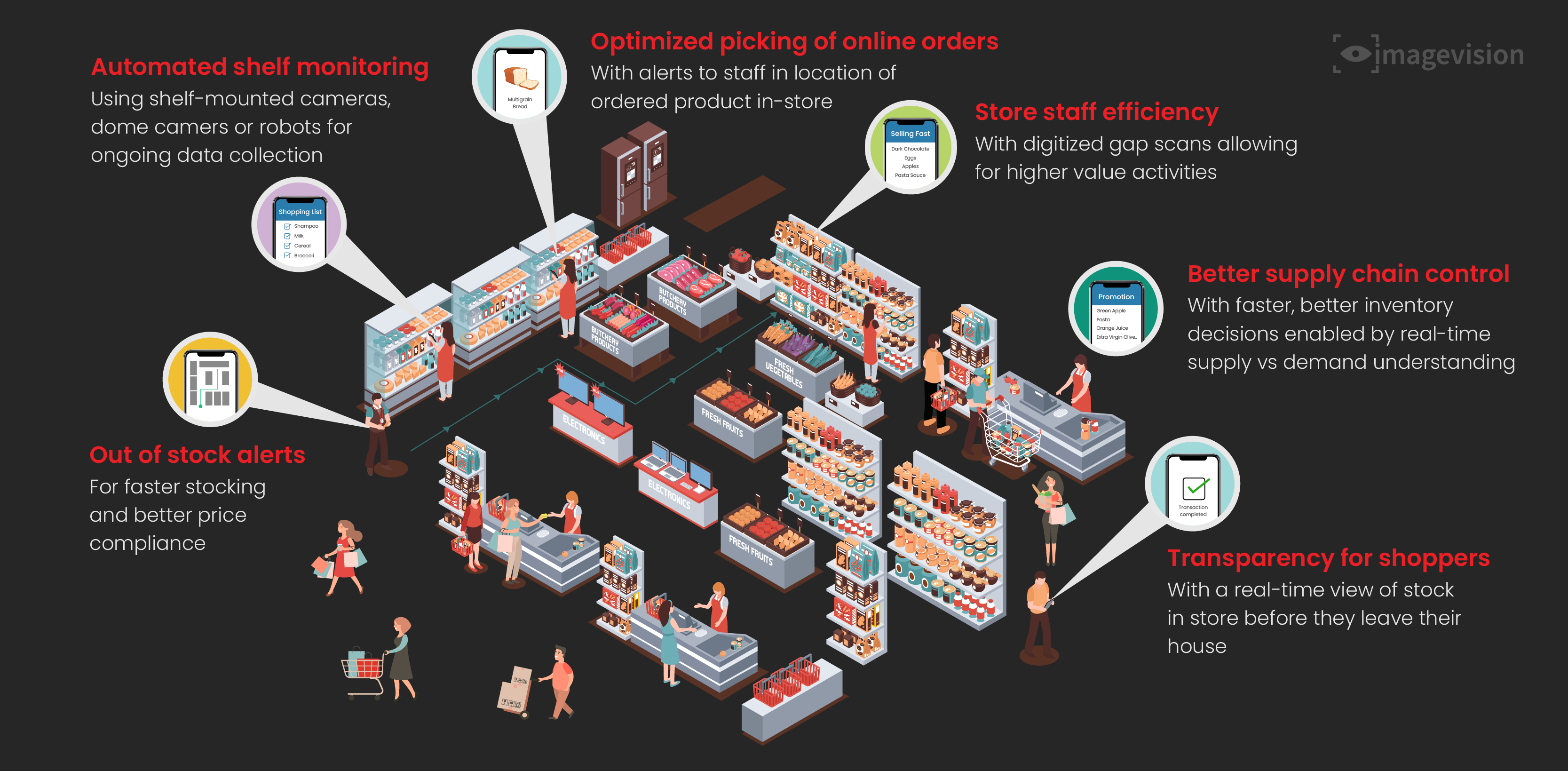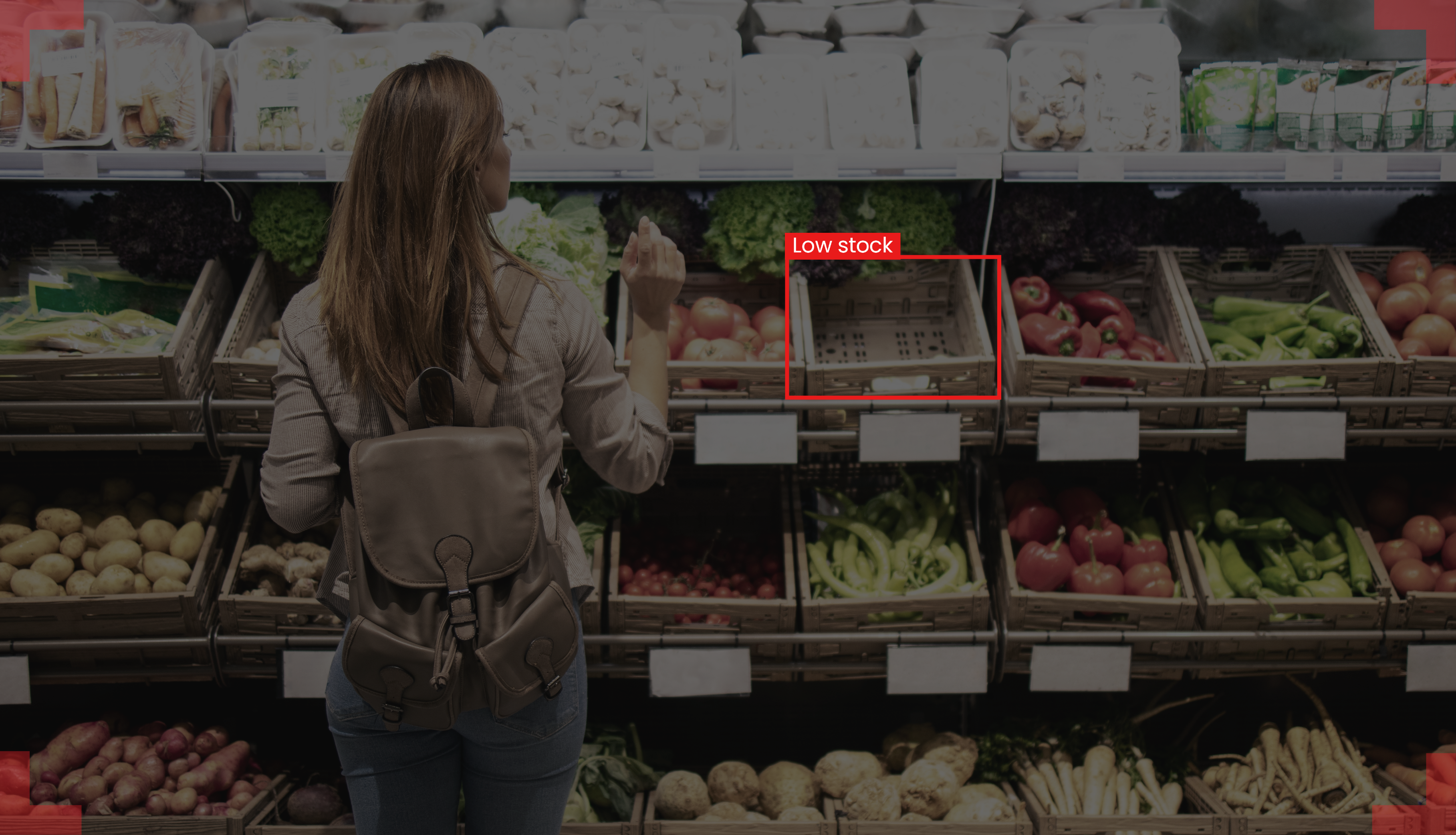Computer Vision for Retail Shelf Monitoring: Optimizing On-Shelf Availability
- Wanpherlin M Shangpliang
- February 19, 2024
Product availability is directly linked to revenue and customer satisfaction for retailers. When shelves are well-stocked, customers find what they need, sales remain consistent, and brand loyalty strengthens. However, when key products are missing, retailers risk losing sales, decreasing foot traffic, and damaging customer trust.
On-shelf availability in retail (OSA) is a critical factor in maintaining operational efficiency and profitability. Studies by Corsten and Gruen highlight that when a product is out of stock, many customers will either switch brands, delay their purchase, or shop elsewhere, all of which negatively impact revenue. In fact, NielsenIQ reported that in 2021 alone, U.S. retailers lost $82 billion due to stockouts, with weekly losses averaging $1.4 billion and peaking at $1.75 billion in the third quarter. These figures emphasize the need for a more effective and scalable on-shelf availability monitoring solution.
Traditional methods such as RFID tagging and manual inventory checks have been used to track stock levels, but their high costs, labor demands, and accuracy limitations have prevented widespread adoption. This is where retail shelf monitoring using Computer Vision comes in. Leveraging AI-powered image recognition and real-time data analysis, retailers can automate inventory tracking, detect stockouts instantly, and optimize replenishment strategies without costly infrastructure changes.
This blog explores how Computer Vision for retail shelf monitoring improves on-shelf availability management, helping retailers reduce stockouts, improve inventory management, and maximize sales potential.
What is Smart Shelf Monitoring Using Computer Vision?

Smart shelf monitoring using Computer Vision systems leverages AI-powered cameras and advanced image recognition software to give retailers real-time insights. These systems detect low stock or misplaced items, analyze shelf conditions, predict stockouts, and provide deeper insights into shopper interactions to optimize retail operations.
The Growing Importance of Retail Shelf Monitoring
In retail, where customer expectations are continually rising, proactive shelf monitoring is no longer a luxury but is a necessity for sustained success.

1. Improving Customer Experience: Shoppers expect seamless and efficient experience. Ensuring product availability at the right time and place is necessary for their satisfaction. Out-of-stocks lead to immediate frustration and lost sales. Real-time shelf monitoring helps retailers maintain optimal inventory levels, ensuring shelves are consistently stocked. Solutions now integrate with store navigation apps, directing customers to in-stock items for an improved shopping experience.
2. Data-Driven Inventory Optimization: Shelf monitoring provides a continuous stream of real-time product levels and movement data. Retailers can move beyond reactive restocking and adopt predictive inventory management. By understanding depletion rates and analyzing demand trends, businesses can optimize stock levels, reduce instances of overstocking and stockouts, minimize waste for perishable goods, and lower carrying costs. At the same time, ensuring products remain available to meet demand.
3. Uncovering Trends and Insights: Modern retail shelf monitoring with Computer Vision extends beyond basic stock tracking. Advanced analytics provide critical insights into consumer behavior, allowing retailers to assess product performance, placement effectiveness, and shopper engagement. Businesses can fine-tune their merchandising strategies, optimize product placements, and adjust pricing dynamically based on real-time demand and movement trends by analyzing shopper interactions. These insights empower retailers to make data-driven decisions that enhance marketing strategies and boost product visibility.
4. Boosting Sales and Revenue Streams: Empty shelves lead to lost sales, and customers who cannot find their desired products will likely switch to competitors. Ensuring continuous product availability and improving product visibility directly increases sales and prevents customer churn. Insights from on-shelf availability management help retailers identify cross-selling and upselling opportunities, enhance promotional effectiveness, and mitigate revenue loss caused by preventable stockouts.
How Computer Vision Improves Retail Shelf Management
Retail shelf monitoring using Computer Vision solutions is far more advanced than simple image processing tools. These intelligent systems provide real-time monitoring, predictive insights, and automated alerts, enabling retailers to streamline inventory management and prevent stockouts before they impact sales.

- Intelligent Image Capture: High-resolution cameras strategically placed throughout the store, whether overhead, shelf-mounted, or on autonomous mobile robots, capture continuous video feeds of shelves. Increasingly, Edge Computing is being used, allowing real-time image processing at the camera level to minimize latency and reduce network bandwidth demands.
- Vision AI-Powered Image Analysis: Sophisticated AI algorithms, trained on extensive datasets of product images and shelf layouts, perform real-time analysis with high accuracy. These systems can identify product facings and ensure planogram compliance, verifying that products are displayed correctly and according to store layout plans. They detect misplaced items and alert store staff when products are shelved incorrectly. Additionally, they analyze shelf occupancy, measuring not just in-stock or out-of-stock status but also how well-stocked a shelf is and whether products are optimally presented. These AI-driven capabilities can adapt to challenging environments, recognizing products with varying packaging designs, lighting conditions, and shelf arrangements.
- Real-Time Alerts and Insights: The system instantly alerts store personnel when a product falls below a pre-defined stock threshold or a shelf layout deviates from the planogram. These alerts are seamlessly integrated into mobile devices and store management systems for immediate corrective action. Centralized dashboards provide store managers with comprehensive On-Shelf availability performance insights, while APIs allow retailers to connect the system with broader inventory management and supply chain operations. Automating stock tracking and ensuring proactive intervention, retailers can eliminate stockouts before they affect sales.
- Beyond Basic Detection with Predictive Capabilities: The next generation of Computer Vision-powered retail shelf monitoring is moving beyond real-time tracking to predictive analytics. These systems analyze historical sales data, identifying patterns in consumer demand. These systems can forecast demand fluctuations before they occur by monitoring real-time shelf depletion rates and external factors such as local events, promotions, and weather trends. AI-driven forecasting allows retailers to optimize restocking schedules, reduce supply chain inefficiencies, and ensure that products are always available when and where needed.
What’s Next in Retail Shelf Monitoring? A Look Ahead
The evolution of retail shelf monitoring is quickly accelerating, driven by advancements in AI and the increasing demands of the modern retail landscape. Here’s a glimpse of the exciting next steps:
- Real-Time and Proactive Monitoring: Moving beyond reactive alerts, future systems will focus on predictive and proactive interventions. AI models will analyze data to anticipate demand surges, optimize restocking schedules dynamically, and suggest preemptive product reallocation within the store.
- Advanced Analytics for Granular Shopper Insights: Expect even richer data analysis capabilities. Shelf monitoring will integrate with other in-store data sources (like point-of-sale and foot traffic sensors) to paint a holistic picture of shopper behavior. This will answer insights into path-to-purchase, dwell times at specific displays, and the effectiveness of promotions at a hyper-local level.
- Hyper-Personalization at the Shelf Edge: Emerging innovations will enable shelf displays to adapt dynamically based on real-time shopper demographics or individual customer profiles. With Computer Vision powered shopper recognition, retailers can trigger personalized promotions and product recommendations, enhancing customer engagement and driving sales.
- Seamless Omnichannel Integration: Future systems will seamlessly integrate with e-commerce platforms, providing a real-time, unified inventory view across physical stores and digital channels. This will enhance inventory accuracy for online shoppers, streamline click-and-collect fulfillment, and ensure a consistent brand experience across all touchpoints.
Conclusion
Retail shelf monitoring has evolved from a reactive process to an intelligence tool that drives efficiency, customer satisfaction, and revenue growth. With Vision AI, retailers gain real-time visibility, predictive insights, and automated alerts, ensuring shelves remain stocked, operations stay efficient, and customer experiences improve.
As technology advances, the future of shelf monitoring will move beyond simple detection to proactive inventory management, hyper-personalized shopping experiences, and seamless omnichannel integration. Retailers who leverage these innovations will not only prevent stockouts but also unlock new levels of operational agility, deeper shopper insights, and stronger competitive positioning.
Looking to monitor in-store product availability and eliminate costly stockouts? Contact us today to explore how our Retail Shelf Monitoring solutions, powered by Computer Vision, can drive results for your retail business.

